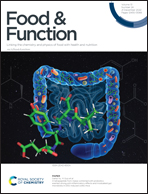Anti-fatigue effects of enzyme-hydrolyzed okara in C2C12 myotubes and Sprague–Dawley rats
Abstract
Okara is a by-product of tofu or soymilk production processes. The disposal of huge quantities of okara is a significant issue. Based on previous reports, protein hydrolysis can release excess free amino acids and small peptides from okara and exhibit anti-fatigue function. We aimed to investigate the anti-fatigue effect of okara protein hydrolysate (OPH) in vitro and in vivo. In the first phase, we treated C2C12 myotubes with different processed OPHs to detect mitochondrial functions. The results revealed that OPH hydrolyzed with alcalase containing 2% E/S for 2 h increased the mitochondrial mRNA level (cytochrome b and cytochrome c oxidase I) and enzyme activity (citrate synthase and cytochrome c oxidase) most efficiently. In the second phase, we conducted animal studies to assess the anti-fatigue function of OPH. After acclimatization, 8 week-old male Sprague–Dawley (SD) rats were randomly classified into four groups: (1) control group, (2) 1X-OPH, (3) 2X-OPH, and (4) 5X-OPH (8 rats per group, treated for 28 days). The results indicated that the intake of OPH for 28 days increased the exhaustive swimming time of rats and lowered the increment of the lactate ratio, as well as the activity of lactate dehydrogenase and creatine kinase. These results indicated that OPH improves exercise performance and anti-fatigue function in male SD rats. Therefore, OPH could be a potential health supplement for anti-fatigue function.



 Please wait while we load your content...
Please wait while we load your content...